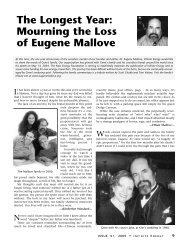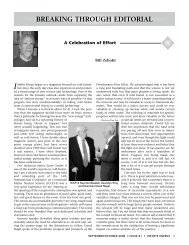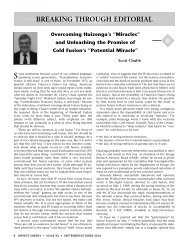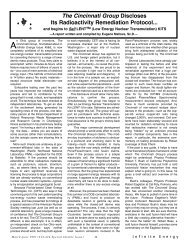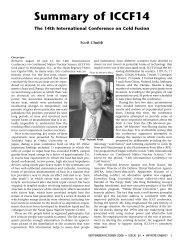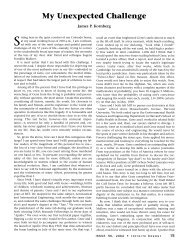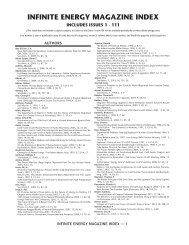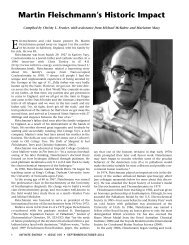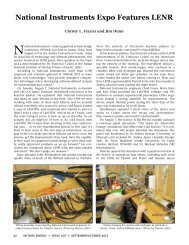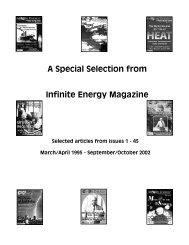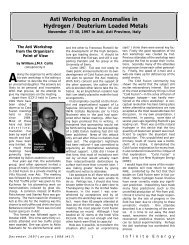MIT and Cold Fusion: A Special Report - Infinite Energy Magazine
MIT and Cold Fusion: A Special Report - Infinite Energy Magazine
MIT and Cold Fusion: A Special Report - Infinite Energy Magazine
Create successful ePaper yourself
Turn your PDF publications into a flip-book with our unique Google optimized e-Paper software.
a deadline <strong>and</strong> it may be six hours long <strong>and</strong> all that stuff, you<br />
really need to see what was going on.<br />
Tate: What was your impression of what was happening?<br />
Ballinger: It was a fairly well-orchestrated attempt to, in my<br />
mind, short circuit in this case well-established <strong>and</strong> well-recognized<br />
review process for any kind of research much less this<br />
kind of research <strong>and</strong> get uh—diversion of funds to uh from the<br />
government from other projects presumably to the University<br />
of Utah. And, uh, they used uh you know. If you assume that<br />
what they are saying is correct, you may argue about the heavyh<strong>and</strong>edness<br />
of what their logic is of their methods, but for<br />
something that’s not been proved to be correct,<br />
the fact that they used this (xxx) was<br />
going on plus the fact that (xxx). . .<br />
Ballinger: If you don’t look at the tape, you<br />
should read Ira <strong>Magazine</strong>r’s testimony. He<br />
is the consultant that they hired to uh . . .<br />
Parker: Is he the one who went into this<br />
society in Rome?<br />
Ira <strong>Magazine</strong>r<br />
He later played a role<br />
in the Clinton Administration<br />
on health policy.<br />
Photo: Courtesy White<br />
House<br />
Ballinger: He made a very, you know, a<br />
very pseudo-truth — that’s the word I’d<br />
use. You start out with something which is<br />
fundamentally true, but everything is not so<br />
true after that. We are, in fact, getting killed<br />
by the Japanese. I mean we’re great inventors,<br />
but we don’t do a good job of bringing<br />
things to market. The Japanese are excellent<br />
at that <strong>and</strong> were getting beaten. We’re getting our ass beaten,<br />
right? And that’s the argument that he used, we should definitely—we<br />
should stuff all kinds of money in here, we should<br />
go on parallel paths, we should establish a center—an international<br />
center in Utah, naturally in Utah, because that’s where<br />
the best scientists are. And we should get going on this right<br />
away. That makes sense, if you’re trying to, if you have an<br />
established, verified product. You know, I mean I think I agree<br />
that we’re getting killed by the Japanese <strong>and</strong> so therefore we<br />
should —there has to be a way to augment the way we do that<br />
kind of thing. But he started from a fundamental assumption<br />
which was not correct, <strong>and</strong> that is, we don’t have anything<br />
that’s proven, <strong>and</strong> moreover not only do we not have anything<br />
that is proven, but there’s a lot of reason to believe that not only<br />
will it be disproven, but it will turn out that it’s not correct.<br />
Tate: Let me ask you, just back up a step. You’re talking<br />
about—I presume you’re talking about traditional scientific<br />
controls <strong>and</strong> traditional scientific methods that have not been<br />
observed in this particular situation.<br />
Parker: This is sci— I’ll give you a quote: This is scientific<br />
schlock, Okay.<br />
Tate: Tell me specifically what they’ve done.<br />
Parker: [Parker laughs].<br />
Tate: That is that may. . .<br />
Parker: I’ll just tell you about the neutrons, Okay.. That’s really<br />
important, Okay. They’ve taken some data. They didn’t even<br />
take it themselves, they had people take it for them. They published<br />
it in their paper <strong>and</strong> they claimed that it showed the presence<br />
of neutrons from their experiment. The data is patently,<br />
has been patently falsely interpreted. Neutrons are not present<br />
at anywhere near the level their own data shows. They’re not<br />
there. They’ve misinterpreted their results. They falsely interpreted<br />
their results. Whether they did this intentionally or not I<br />
don’t know, but they did not present—interpret their results<br />
correctly. It’s a key point in their paper.<br />
Tate: Specifically what they’re claiming, that it was neutrons<br />
they were creating. . .<br />
Parker: That they were creating neutrons from their experiment.<br />
Their documentation unfortunately shows that not only<br />
was it falsely interpreted, but there were no neutrons at anywhere<br />
near the level they claimed. You can use the data in two<br />
ways, to show that they falsely interpreted it, but also that there<br />
weren’t neutrons at the level they claimed.<br />
Tate: So at best it’s misinterpretation <strong>and</strong> at worst it’s — as you<br />
were saying. . .<br />
Parker: It’s fraud.<br />
Tate: Now do you know this from studying their research,<br />
from reviewing their information, or have you tried—<strong>and</strong> I presume<br />
you’ve, in addition, attempted to parallel what they’ve<br />
done?<br />
Parker: We reproduce their results so we completely underst<strong>and</strong><br />
why they misinterpreted. Let me put it a different way, we<br />
don’t see why they misinterpreted, we don’t underst<strong>and</strong> what<br />
they should have seen <strong>and</strong> didn’t.<br />
Tate: So you’ve reproduced their experiment?<br />
Parker: We’ve simulated the neutrons. We’ve said, suppose<br />
there were no neutrons, what would it have looked like? And<br />
we find something quite different from what they claim.<br />
Ballinger: We find what we should expect.<br />
Tate: Would you care to speculate on their intent?<br />
Parker: I think Ron made it perfectly clear that when you’re<br />
asking for $125 million for the university, I mean I don’t want<br />
to be tied into that quote, but I mean you have to draw the<br />
(xxxx). They were in Washington Wednesday asking for $125<br />
million dollars.<br />
[Editor’s Note: At this point in the interview, Parker gets a phone call<br />
from Dr. Richard Garwin of IBM Corporation, one of the key people<br />
on the U.S. Department of <strong>Energy</strong>’s cold<br />
fusion review panel. . .]<br />
Parker (to Garwin): I just talked to<br />
Richard [Petrasso] who wrote the<br />
Nature piece. I don’t know if you saw<br />
that? But he <strong>and</strong> I basically chuck it off,<br />
I mean you know I said his piece was<br />
the best thing written so far. And he told<br />
me he saw the original submission <strong>and</strong><br />
it did have the line at 2.5 [MeV]. The<br />
original submission had the line at 2.5<br />
so, you know that’s, uh, the smoking<br />
Dr. Richard Garwin<br />
Photo: IBM Corporation<br />
gun with fingerprints, Okay, you don’t even need (xxxx). Oh,<br />
gee, I don’t want to quote him, but that’s a good question, but<br />
the original submission to the journal had 2.5, just as the 2.5 in<br />
the equation, so you know now it transcends I think the question<br />
of whether they misinterpreted to the question of whether<br />
there was deliberate fraud. Okay, alright. . .(xxx). Well, all your<br />
detective work was correct, but now he has the smoking gun<br />
with the fingerprints on it, right? [Laughs] Okay, right, see ya!<br />
Bye. . .<br />
Parker: So I thought he would be good to talk to <strong>and</strong> he just<br />
volunteered. He’d seen the original submission to the journal.<br />
The line was at 2.5.<br />
Ballinger: That’s what we suspected.<br />
25 <strong>Infinite</strong> <strong>Energy</strong> • ISSUE 24, 1999 • <strong>MIT</strong> <strong>Special</strong> <strong>Report</strong>



